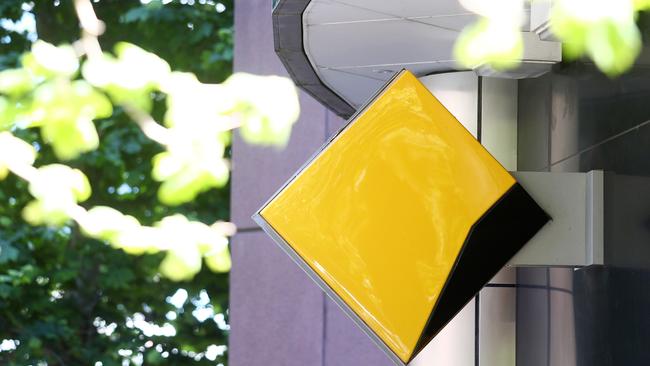CBA customers losing out on super payments
A superannuation fund the CBA runs for its employees is paying returns that are much higher than returns for the public.

A superannuation fund the Commonwealth Bank runs for its employees and their families is paying returns on uncomplicated and low-risk cash investments that are much higher than returns the bank pays members of the public for an identical product.
CBA’s GroupSuper, which it also refers to as “OurSuperFund”, pays its members returns on cash investments that are up to 82 percentage points higher than the returns the CBA pays tens of thousands of members of the public who collectively hold $165 million in cash in the CBA’s Colonial First State FC AP-CFS Cash investment option.
Data from super ratings agency SuperRatings shows that in the year to March, the CBA GroupSuper fund, which CBA operates for “employees, past employees & their spouses”, paid retired fund members — said to be in the “pension” phase — a return on cash investments of 2.01 per cent, roughly in line with the underlying market rate.
But during the same period, CFS Cash paid a return on cash investments of just 1.19 per cent to retired CBA super fund members, an 82 percentage point difference, or 69 per cent, in returns for the same investment product.
Comparing returns on cash investments for those fund members still in the workforce — and so said to be in the “accumulation” phase — by analysing data provided by the CBA to SuperRatings shows the CBA employee fund paid returns that were between 40 per cent and 60 per cent higher, depending on individual tax circumstances.
The nation’s $2.6 trillion superannuation industry has been under scrutiny since the Productivity Commission two weeks ago released a scathing report saying the sector was failing to deliver for millions of Australians.
The report found billions of dollars of the public’s money was being lost every year in unnecessary fees and insurance premiums as a result of people having “unintended multiple accounts”, with Finance Minister Kelly O’Dwyer labelling those fees and premiums a “massive rip-off”.
Retail super funds, the majority of which are owned by the nation’s major banks, were singled out as being especially poor performers, delivering returns well below market rates and the returns of not-for-profit funds, even after accounting for all the “reported” fees that those retail funds charged investors.
A series of exposes by The Australian over the past six weeks has revealed super funds owned by the big four banks have been gouging investors in many ways, including by paying them returns on investments that are as low as one quarter of market rates.
When an investor joins a super fund they will usually be asked to choose what types of investments they want their money to be spread across, and so choose from a list of options such as the lowest-risk option, “cash”, Australian commercial property, or international shares.
The SuperRatings data is highly informative because rather than looking at the performance of overall “funds” it breaks down what the actual performance has been of individual “investment options”, after fees and other charges have been taken out; that is, what the investor gets, in the hand, for the money they have in each investment option.
The Australian has obtained the most recent and detailed performance data from SuperRatings to the end of March, and revealed that many investment options operated by the retail super funds are paying returns well below the actual market rates, with those lower returns not explained by differences in fees.
Reports by industry analysts — and even the Australian Prudential Regulation Authority — show that, as a whole, bank-owned super funds deliver systemically lower returns than other types of funds.
In their defence against, the banks have argued such analysis does not compare investments “like-for-like”.
This is why The Australian has investigated returns paid on cash investment options: those investments are uncomplicated and the market rate for returns on cash investments is publicly known.
The Australian asked the CBA why investors in the “pension” phase of the CBA GroupSuper fund, who collectively had $29m invested in its cash investment option, had been paid a 2.01 per cent return on those cash investments when “pension” phase members of CBA’s CFS Cash investment option, who had $165m invested, were paid 1.19 per cent. CBA spokeswoman Robyn Tolhurst said the difference was fees.
“The key difference in the returns is due to the fees,” Ms Tolhurst said.
“The fee payable on the (CFS Cash investment option) includes fees paid to the adviser and administration fees.”
Ms Tolhurst went on to refer to a CBA super fund (The Australian had not inquired about super funds, but the investment options those funds invest in) called FirstChoice, FC Wholesale Pension.
Ms Tolhurst said the cash investments on that super fund were a better comparison with the cash investments in the CFS Cash investment option, because it remained open to new investors.
Despite the fact that the CFS Cash option holds $165m of fund members super, and continues to fully operate and charge fees to tens of thousands of CBA super members invested in it, it had been “closed” to new investors and so is referred to as “closed” by the CBA.
“The comparison you provided of (CFS Cash investment option) and Commonwealth Group Super AP Cash Option does not compare like with like,” Ms Tolhurst said. “Therefore, it is not an appropriate comparison.’’
As previously reported, many retail funds regularly “close” investment options to new investors, but keep them operating and charging fees to thousands of existing investors.
SuperRatings and fellow ratings agency Rainmaker have said those so called “legacy” investment options often performed very poorly, largely as a result of high fees, and that after super funds “closed” those investment options they were far less likely to disclose their performance figures.
Ms Tolhurst said the comparisons between the cash investments in the staff fund and the public CBA Colonial First State cash fund were skewed because the reported returns of 1.19 per cent did not include “all fees” charged to those members of the public.
She said the SuperRatings data “doesn’t subtract the dollar-based administration fees charged by some funds (eg $1.50 or $2 per week fee) in the performance numbers”.
However, The Australian pointed out that if this were the case, then the 1.19 per cent return reported for the public cash fund would fall, not rise.
The CBA did not respond directly to this statement or to calculations provided by The Australian showing the fund’s reported return would fall if more fees were added to that reported return.
*An earlier version of this story stated the CBA staff returns were 82 per cent higher, they are actually 82 percentage points higher, meaning they are 69 per cent higher.


